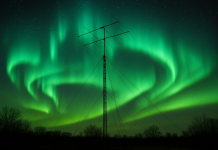Have you ever heard about the WOW! signal?
The “Wow!” Signal picked up by a SETI experiment at Ohio State University in 1977 often gets mentioned, as it was the first time an ambiguous and still unexplained signal was picked up by at SETI experiment.
The “Wow!” signal was not witnessed in real time but rather was picked up over night while the experiment was running. Radio Astronomer Jerry R. Ehman saw the signal on a computer printout the next morning and circled it with the word “Wow!” next to it:

The area which the “Wow!” signal of 1977 came from was not centered on any particular star. That area of sky has been searched several times since then and nothing was ever found. There was even a 72 second reply mimicking the original signal sent to the area of sky “Wow!” originated. This was done in 2012 by the mostly useless “Chasing UFOs program on NatGeo. Here a record of the sound:
Creepy isn’t it? But it is not finished!
In 2010, SETI picked up a new “Wow!” type signal. Unlike the 1977 signal this one was not from that fairly blank area of sky. This new Wow signal seemed to come from the vicinity of a star called TYC 1220-91-1. Moreover, this new unexplained signal was detected and tracked in realtime during 10 seconds. This new “Wow!” signal exhibited the characteristics an interstellar beacon signal might be expected to, with the exception that it did not repeat.
That incident is mentioned on page 12 of the following paper on a new theoretical type of alien beacon: “A new class of SETI beacons that contain information” (Aug 22, 2010).
As described in a Figure caption:
[quote_box_center]Figure 4 for example shows a result obtained in a narrowband SETI search near
the PiHI frequency (the number π times the HI observing line of 1420.4 MHz). This (extremely
powerful) ~10 second pulse of narrowband radiation appeared in one 50 second observation
period but was never re-observed. This pulse has interesting features: It is observed at a magic
frequency in the direction of a nearby and potentially habitable star. Yet we cannot be sure this
signal was created intentionally or unintentionally by some transmitter on Earth. Hence after
multiple observations over 2 weeks and no re-detection, we gave up (although this direction is
added to a catalogue of directions to re-observe as time permits).[/quote_box_center]
One thing to note from the above information is that SETI did two things upon detecting such a signal:
1 – They published a paper which included all the relevant information on it.
2 – They never claimed the signal to be definitive evidence of aliens, though it looked from their perspective to be a signal of extraterrestrial origin.
Instead they took a cautious approach, as they should. They didn’t scream “aliens”… But remember the signal came from a nearby and potentially habitable star.













It’s true
[…] Fast radio bursts are bright blasts of radio energy that last for just a few milliseconds and are never seen again. They were first detected in 2007 and up to now only 9 had been cataloged. This new type of fast radio burst, the double flash, rules out some possible origins. But the mystery remains… […]
[…] do they show signs of bizarre alien life or are we simply seeing what we want to […]
[…] These are the first fast radio bursts from an extragalactic source detected in the northern hemisphere and with another telescope than the Parkes radio telescope. This is probably also one of the many reasons why scientists are concerned about the astrophysical nature of these weird alien pulses. […]
[…] is not the first unknown and mysterious space signal captured from outer space, but it is the latest to […]
[…] working at an Australian observatory picked up a series of fleeting but powerful radio signals. These signals have never been detected elsewhere, casting doubts on their origin. But now, new […]